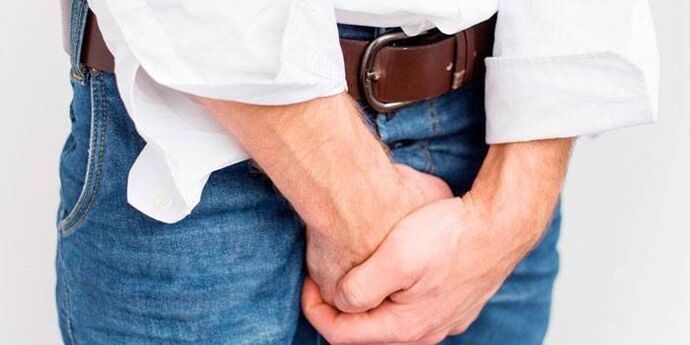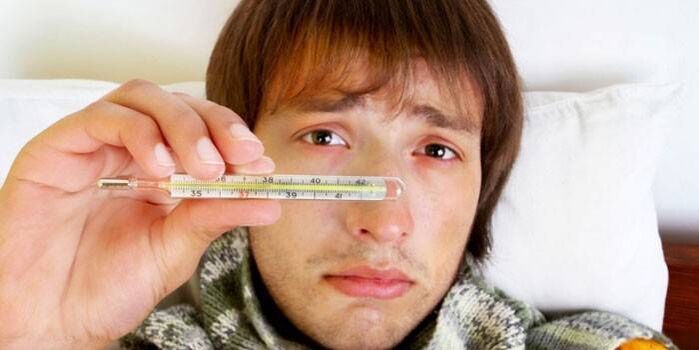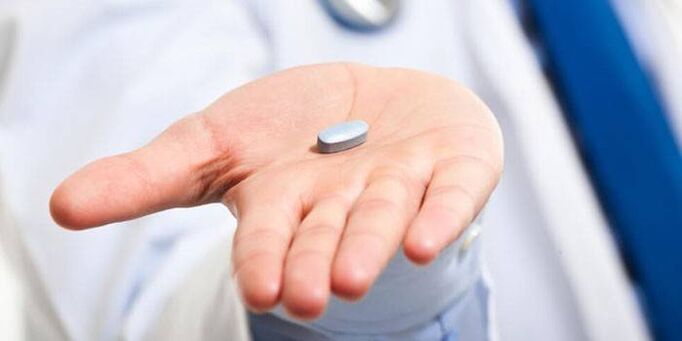Every second male of reproductive age (up to the age of fifty) is susceptible to subtle diseases such as acute prostatitis. Under the influence of certain factors, the prostate (prostate) becomes inflamed, leading to various forms of sexual dysfunction. Function, fertility and psychoemotional state. Pay attention to what your body says and don't neglect prompt treatment.
What is acute prostatitis
If a man feels discomfort or even pain when urinating, he should seek medical attention immediately, because acute prostatitis is a contagious disease that can cause inflammation of the prostate gland, and then form edema of the glandular tissue and form a foci of purulence. on top. If signs of acute inflammation of the prostate are not heeded, the pathological process can devolve into a chronic form that is difficult to treat and leaves little time for reflection - the transition occurs within days.
However, more serious complications than its transformation into a chronic form are possible. There is a risk of sepsis - general infection of the blood and ascending infection of the urinary tract, with the development of pyelonephritis and cystitis. In these cases, the patient is hospitalized urgently and may be in critical condition. Although sepsis as a complication is rare, it can occur in patients with immunosuppressed conditions - poisoning, fever, severe symptoms, weakness. Therefore, blood cultures are required to detect microorganisms.
Symptoms of acute prostatitis
Everyone needs to know and remember the symptoms of acute prostatitis. The general symptoms of the disease are:
- Severe pain when urinating.
- Body poisoning.
- Urinary disturbances (intermittent, weak, strained flow).
- I often want to go to the toilet at night.
These are external symptoms of prostatitis, but with more in-depth research, traces of white blood cells, mucus and pus in prostate secretions are found in the urine. On palpation, a dense, enlarged organ will be felt, and it will be painful to press. The further development of the inflammatory process is characterized by heaviness and pain in the perineum, radiating to the penis, sacrum and rectum. As a result, the patient has difficulty emptying the bladder and defecation due to severe pain. Body temperature can rise to 38°C.

Causes of acute prostatitis
Since the disease is bacterial in nature, the following infectious agents are responsible for acute prostatitis:
- Gram Negative - Klebsiella, Escherichia coli, Proteus.
- Gram-positive - Enterococcus, Staphylococcus, Streptococcus.
- Urogenital system - trichomoniasis, chlamydia, ureaplasmosis, gonorrhea, candidiasis, mycoplasma.
The microflora usually penetrates into the glandular tissue of the prostate via the transcanalicular route (through the urethra and excretory ducts of the prostate). In cystitis, the infection migrates from the bladder to the prostate. Other possible routes of bacterial penetration are opened during intraurethral procedures (catheter placement, urethral exploration, cystoscopy, urethroscopy). Pathogenic microorganisms migrate to the prostate from distant lesions of dental caries, sinusitis, tonsillitis, cholecystitis, pyoderma, bronchitis.
Proctitis, hemorrhoid fissures, and colitis have a high chance of infecting the bowel. Non-infectious factors that can lead to prostatitis flare-ups are hyperemic (congested) venous phenomena in the pelvic region and impaired drainage of glandular acinars. Congestion may be caused by irregular or opposite excessive sexual activity, interrupted sexual intercourse, sedentary lifestyle, frequent constipation, frequent alcoholism, small pelvic varicose veins, hypothermia.
forms of acute prostatitis
The clinical development of this disease is divided into three stages, and it is also a form of acute pancreatitis. This is:
- The first stage is the catarrhal form.
- The second stage is follicular morphology.
- The third stage is the substantive form.
Acute prostatitis in men begins with catarrhal inflammation, which is characterized by acinar expansion and edema of glandular tissue, resulting in increased organ size. The prostatic excretory duct leading to the posterior urethra is actively involved in the inflammatory process. The lobules and ducts of the prostate become inflamed, their contractility is disturbed, they narrow and become blocked, which makes it difficult to secrete the secrets of the prostate.
During the catarrhal phase, the pathological process stops at the mucus layer and does not go deeper. As it progresses, the disease spreads throughout the prostate. Development of follicular acute bacterial prostatitis. surfaced in urine pus analysis. Destructive changes in glandular tissue occur, and swelling continues to increase. The follicular form can still receive relatively easy treatment.
In addition, a substantial form of the disease develops, the result of which can be a prostate abscess, ie chronic prostatitis. Therefore, the following symptoms appear:
- Body temperature rises to 39°C and above.
- Poisoning manifestations: weakness, chills, thirst, loss of appetite.
- The urge to go to the toilet frequently to satisfy a small need is accompanied by severe pain.
- Inability to empty the bladder.
- flatulence.
- Tenesmus.
- constipate.
- Mucus is discharged from the anus.

Diagnosis of acute prostatitis
At first I suspected that it was inflammation of the prostate, so I rushed to see a doctor. Correct and comprehensive diagnosis of acute prostatitis is important for rapid and successful treatment. The doctor will first analyze the medical history to determine when the pain in the perineum occurs and whether the pain increases or decreases during ejaculation, urination, and bowel movements. Make sure the doctor has to study the patient's medical history: which diseases have been transferred, whether there are sexually transmitted infections.
The urologist will palpate the external genitalia for developmental pathology, obvious signs of prostatitis, and a rectal examination - palpation of the prostate through the anus. To create a complete clinical image, the following checks are necessary:
- Urinalysis to determine white blood cell levels and the presence of purulent lines.
- blood test.
- Culture smear - The contents of the urethra and scrapings are taken to determine the growth of bacteria and their susceptibility to antibiotics.
- Measurement of urine flow velocity (uroflowmeter).
- Prostate ultrasound detects diffuse changes in the gland and its abscess formation.
- Blood tests to determine the presence of pathogens for diseases such as syphilis, gonorrhea, mycoplasmosis, chlamydia, and more.
- PCR diagnosis.
Treatment of acute prostatitis
After a thorough diagnosis, they started treatment for acute prostatitis. It is based on antibiotic therapy and its purpose is to suppress infectious pathogens. In addition, conservative treatment of prostatitis includes the use of:
- Anti-inflammatory drugs.
- Means of improving blood circulation.
- Painkillers and antispasmodics.
- Medications that support metabolic processes in the prostate.
- Various vitamins.
- Phytotherapy.
- Immunomodulators.
Advanced forms of prostatic inflammation with the appearance of purulent foci require surgical intervention. Transurethral (through the urethral wall) or transrectal (through the anal wall) drainage of the abscessed area is performed. Surgery may be required in cases of pathological urinary retention. A puncture capsulostomy is performed - an incision is made in the abdominal cavity and a tube is inserted to transfer urine.

drug
Treatment of acute prostatitis in men with drugs (tablets, injections) is the basis for successful treatment. With good antibiotic treatment, the infection can be overcome within a few days. However, it is recommended to continue treatment for 4 weeks to completely eradicate the pathogenic microflora. Medications used for this condition are:
- Etiotropic (antibiotics) - destroy pathogens.
- Pathogenic (NSAIDs) - Eliminate prostate congestion.
- Symptomatic (analgesics, antipyretics) - relieve pain, organ muscle spasms and other symptoms.
To treat prostate inflammation, doctors may prescribe a variety of medications, including:
- Injection - helps the drug penetrate into body tissues in a short period of time.
- Candle (rectal) - analgesic, antibacterial effect.
- Instillation - The drug is delivered to the prostate through the opening of the urethra.
- Microclysters with herbal soup.
- Antibacterials with broad-spectrum action if the specific causative agent of the disease has not been identified.
Antibiotics for acute prostatitis
The main pathogens of prostatitis are pathogenic bacteria that cause inflammation of prostate tissue. Therefore, antibiotics for acute prostatitis are the basis of treatment and can only be prescribed after testing for microbiota susceptibility. Antibacterial drugs used for inflammation are divided into the following groups:
- Fluoroquinolones.
- penicillin.
- cephalosporins.
- Macrolides.
- tetracycline.
- Aminoglycosides.
Prevention of acute prostatitis
In order for a man to be always healthy and full of strength, it is important to prevent acute prostatitis, including:
- Regular sex with a regular partner, excluding casual relationships.
- Use condoms.
- Quit smoking, drugs, alcohol.
- proper nutrition.
- personal hygiene.
- Preventive annual checkup by a urologist.
- Take vitamins and zinc preparations.
It is very important to completely cure urogenital diseases (urethritis, cystitis, pyelonephritis, balanoposthitis). An undertreated disease can lead to the development of an inflammatory process in the prostate. Among other things, we cannot forget to increase physical activity. During the cold season, hypothermia should be avoided. Prostate massage is very useful for men's health. However, if the disease has made itself felt, massage is contraindicated or even impossible because of the soreness of the organs.



























